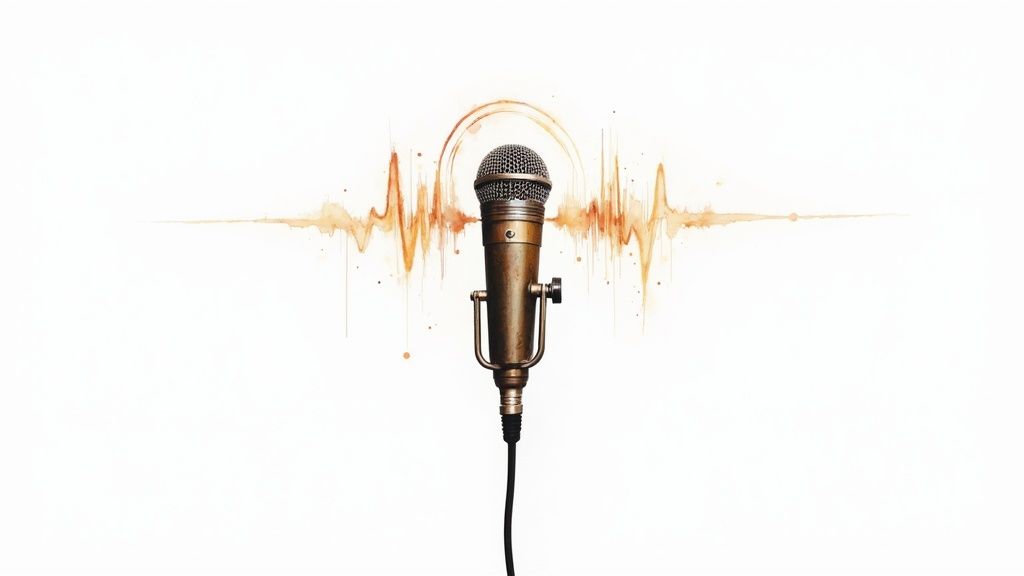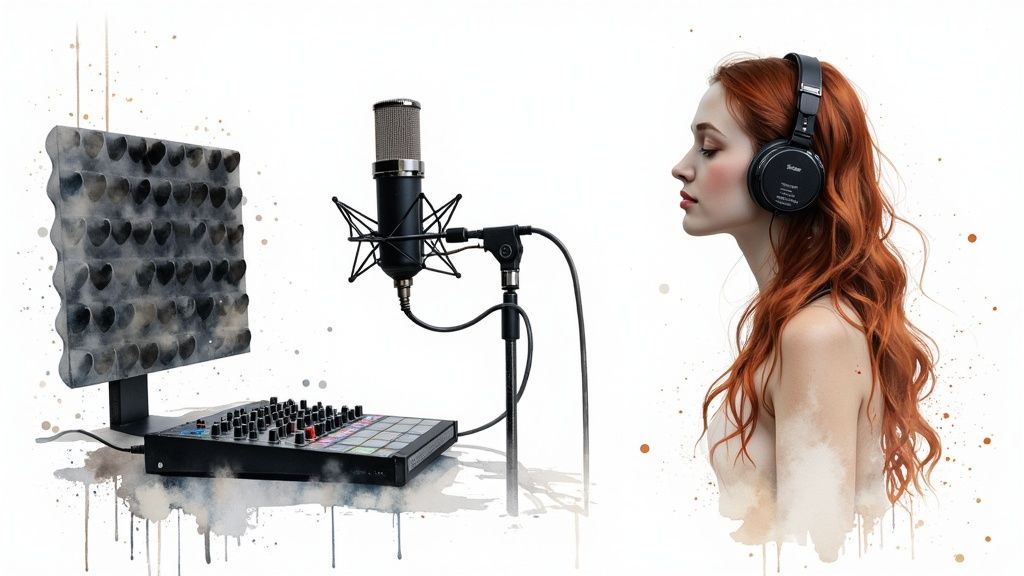The Voiceover Landscape: Where Beginners Fit In

So, you're dreaming of a career in voiceovers? That's exciting! The voiceover industry is a vibrant and expanding field, brimming with possibilities for skilled voices. This section offers a practical overview, designed to help beginners navigate this exciting world.
Understanding the Current Market
The voiceover market isn't a single entity. Instead, it's a rich tapestry of specialized areas, each with unique requirements and opportunities. Think about commercials, narration, animation, video game characters, e-learning content, and corporate presentations. Each demands a distinct skill set and approach to voice acting.
This diversity is great news! It means you can likely find a niche that perfectly complements your natural abilities and passions. However, understanding the current market demands is key to your success.
The accessibility of the voiceover industry has also transformed. Once a fairly exclusive domain, the advent of digital platforms and home studios has opened doors for aspiring voice actors everywhere. But this increased accessibility also brings more competition.
Where the Opportunities Lie
For beginners, certain niches within voiceover often offer easier entry points. E-learning and corporate narration, for example, are consistently in high demand. These fields often prioritize a clear, engaging, and professional delivery over highly specialized character voices.
This makes them excellent starting points for honing your skills and building a strong portfolio. Similarly, indie game development frequently presents opportunities for newcomers eager to gain experience on smaller projects.
The rise of online platforms like Fiverr and Upwork has also created dynamic marketplaces where voice actors can connect directly with clients. This offers a valuable avenue for gaining practical experience and building a reputation, even without representation.
However, it's important to be realistic about income expectations on these platforms. While they offer a good starting point, rates can be competitive, and building a solid client base and commanding higher fees takes time and effort.
Realistic Income Expectations
The financial aspect of voice acting is a crucial consideration. While established voice actors can earn impressive salaries, starting rates are generally more modest. Numerous factors influence earnings, including experience, specialization, union membership, and project scope.
The global voiceover market has experienced significant growth, reaching an estimated USD $4.4 billion in 2024. This indicates a robust and expanding industry, fueled by rising demand for voiceovers across various sectors like entertainment, marketing, and educational content. You can learn more about this growth here.
This market growth translates into real opportunities. However, grasping the industry’s financial realities is essential. Research typical rates for various voiceover work and establish realistic income goals as you embark on your journey. Building a sustainable voiceover career requires consistent effort and dedication – it’s a marathon, not a sprint.
Building Your First Studio: Equipment That Actually Works
Forget the overblown promises about pricey gear. Building a professional-sounding voiceover studio at home is much easier than you might think. This section breaks down the essential equipment you actually need, drawing on advice from working voice actors and audio engineers. We'll focus on practical setups that deliver professional results, whatever your budget.
The Heart of Your Setup: Microphones
Your microphone is the foundation of your voiceover work. The right choice depends on your budget and the style of voiceover you’re pursuing.
-
Budget-Friendly Options (Under $150): Dynamic microphones like the ATR2100x-USB are surprisingly capable for beginners. They handle loud sounds well, a plus for newcomers. Being less sensitive than condenser microphones, they minimize background noise, a real advantage in imperfect recording spaces.
-
Mid-Range Marvels ($150-$500): Condenser microphones such as the Audio-Technica AT2020 offer a noticeable jump in sound quality. They capture the subtleties of your voice with greater clarity. This results in richer, more engaging recordings. Keep in mind, this sensitivity also means they pick up more background noise.
-
Professional Powerhouses ($500+): High-end condenser microphones like the Neumann TLM 103 are an industry standard for good reason. They offer exceptional clarity, warmth, and detail. While more expensive, the boost in quality is often significant.
Creating Your Acoustic Oasis: Sound Treatment
Effective sound treatment is as important as your microphone. It minimizes unwanted reflections and controls background noise for cleaner recordings. Think of it like adjusting lighting in photography.
-
DIY Acoustic Panels: Affordable acoustic foam panels, strategically placed around your recording area, absorb reflections and reduce echo. This is a budget-friendly way to dramatically improve your recording environment.
-
Sound Blankets and Curtains: Thick blankets or sound-absorbing curtains, hung around your recording space, add another layer of sound dampening. This is particularly helpful in rooms with hard surfaces.
-
The Reflection Filter: A portable reflection filter behind your microphone can minimize room reflections while recording. This is a convenient solution for those without a dedicated studio.
Essential Accessories: Making a Difference
While a good microphone and sound treatment form the base, a few accessories can enhance your setup:
-
Pop Filter: This screen, placed in front of your microphone, reduces plosives – the harsh sounds from "p" and "b" sounds. A small investment with a big impact on clarity.
-
Mic Stand: A sturdy mic stand ensures stability and flexibility while recording. It also reduces handling noise, which can distract from your audio.
-
Audio Interface (for XLR microphones): An audio interface connects your XLR microphone to your computer, providing a clean, high-quality signal.
Troubleshooting Common Challenges
Even with the right equipment, issues can arise in home studios:
-
Background Noise: Identify and minimize noise sources. Even quiet sounds like computer fans can disrupt recordings.
-
Room Echo: Strategic placement of acoustic treatment can significantly reduce echo and improve clarity.
-
Inconsistent Sound Quality: Consistent microphone placement and technique are crucial for every session. Practice makes perfect.
To help you visualize the equipment discussed, here’s a comparison of options at different price points:
Voiceover Equipment That Delivers: Honest comparison of essential voiceover equipment at different price points with real performance insights
| Equipment Type | Budget Option ($50-$150) | Mid-Range ($150-$500) | Professional ($500+) | What You'll Actually Notice |
|---|---|---|---|---|
| Microphone | ATR2100x-USB | Audio-Technica AT2020 | Neumann TLM 103 | Clarity, noise reduction, richness |
| Sound Treatment | DIY Acoustic Foam Panels | Professional Acoustic Panels | Vocal Booth | Reduced echo, improved clarity |
| Accessories | Pop Filter, Basic Mic Stand | Boom Arm, Shock Mount | High-End Cables, Preamp | Minimized plosives, handling noise, improved signal quality |
As the table illustrates, investing more often brings noticeable improvements in clarity, noise reduction, and overall richness of your recordings. However, even budget-friendly options can produce good results with proper technique and sound treatment.
By focusing on these core elements, you can build a home studio that produces professional voiceovers, allowing you to deliver great results. This foundation will prepare you to explore advanced techniques, turning your talent into polished performances.
Voice Techniques That Transform Your Delivery

Your voice is a remarkable tool. Even in its natural form, it holds a unique character just waiting to be honed and strengthened. This section explores practical techniques, drawn from experienced professionals, to elevate your voiceovers from amateur to polished performances.
Breathing Life Into Your Voice: Essential Exercises
Just like athletes condition their bodies, voice actors refine their voices. Regular practice cultivates vocal flexibility and control, the foundations of engaging delivery.
-
Diaphragmatic Breathing: This technique uses your diaphragm, enabling deeper, more regulated breaths. This is essential for sustaining extended phrases and preserving a steady vocal tone. Consider it the bedrock upon which all other vocal techniques are constructed.
-
Tongue Twisters: These seemingly simple exercises enhance articulation and clarity. Try repeating phrases like "She sells seashells by the seashore," concentrating on crisp enunciation. This strengthens speech-related muscles, enhancing precision.
-
Vocal Warm-ups: Basic humming and scales gently prepare your vocal cords for recording sessions. This prevents strain and broadens your vocal range.
Mastering Microphone Technique: Proximity and Presence
Microphone technique can significantly impact your recordings. Understanding how proximity affects your sound unlocks numerous possibilities.
-
Proximity Effect: This phenomenon, often seen with directional microphones, amplifies bass frequencies as you approach the microphone. This can add warmth and intimacy, but avoid overusing it.
-
Microphone Placement: Experimenting with position lets you fine-tune your sound. Small adjustments in angle or distance can dramatically alter the tone and presence.
-
Pop Filters and Windscreens: These vital tools minimize plosives (harsh "p" and "b" sounds) and unwanted breath noise, resulting in cleaner recordings.
Script Interpretation: Connecting With Your Audience
Effective voiceover goes beyond reading words; it conveys emotion and meaning. Here's how accomplished voice actors achieve this:
-
Understanding the Context: Before recording, grasp the script's purpose and intended audience. Who are you addressing, and what message are you sharing?
-
Emphasis and Inflection: Varying tone and pace keeps listeners engaged and underscores key information. It adds punctuation to your speech, guiding your audience.
-
Emotional Connection: Injecting genuine emotion into your delivery adds depth and authenticity, allowing listeners to connect with sincerity.
This connection drives a thriving market. The voiceover market is expected to grow by 9% annually as of 2024. North America currently leads, but Europe and Asia are expanding rapidly, creating opportunities across languages and accents. For more statistics, see this article.
Maintaining Vocal Health: Endurance and Recovery
Voice acting, particularly long sessions, can strain your vocal cords. Protecting your voice ensures a long, healthy career.
-
Hydration: Staying hydrated is vital. Water lubricates your vocal cords, preventing dryness and irritation.
-
Vocal Rest: Regular breaks during sessions allow your voice to recover. Even short silences help.
-
Warm Down: Cooling down after recording, with gentle humming and deep breathing, prevents vocal fatigue.
Overcoming Self-Consciousness: Finding Your Authentic Voice
Many beginners experience self-consciousness, which hinders performance. Overcoming this is crucial for reaching your full potential.
-
Practice and Preparation: Increased practice builds confidence. Thorough preparation lets you focus on delivery, not technicalities.
-
Record and Review: Listening to your recordings identifies areas for improvement and promotes self-awareness, revealing strengths and weaknesses.
-
Embrace Imperfection: Strive for authentic delivery, embracing your unique vocal qualities. This is what distinguishes you. You might find this guide helpful: How to master video voiceovers.
By incorporating these techniques, you’ll transform your voiceovers into captivating performances. Consistent effort and genuine passion are key to achieving professional results in the expanding world of voiceovers.
Recording and Editing: From Raw Takes to Polished Audio

This section breaks down the technical side of voiceover production. We'll turn recording and editing from potential roadblocks into practical skills you can use with confidence. Our focus will be on efficient workflows and solutions to common audio problems, showing you how to bring raw audio to life.
Choosing Your Software: Features That Matter
Picking the right recording software is the first step. While many options exist, knowing which features are essential for voiceovers makes the choice easier.
For example, non-destructive editing lets you experiment freely without changing your original recordings. This gives you flexibility throughout the editing process. Robust noise reduction tools are also vital for cleaning up background noise and other imperfections. Audacity is a popular free and open-source option, while Adobe Audition offers a more professional suite of tools.
To help you compare different software options, here’s a handy table:
Recording Software That Fits Your Workflow: Comparing the actual usability and practical benefits of popular voiceover recording software
| Software | Real Cost | Learning Curve | Features Worth Using | Who Thrives With It |
|---|---|---|---|---|
| Audacity | Free | Beginner-friendly | Noise Reduction, Non-destructive Editing | Beginners, hobbyists, budget-conscious users |
| Adobe Audition | Paid subscription | Moderate | Advanced noise reduction, multi-track editing, spectral editing | Professionals, those seeking advanced features |
| GarageBand | Free (Mac) | Beginner-friendly | Basic editing, effects, royalty-free music | Mac users, beginners, musicians |
| Pro Tools | Paid subscription | Steep | Industry-standard for professional audio production | Professionals, experienced audio engineers |
This table highlights the key differences in cost, ease of use, and features. Choose the software that best fits your budget and technical skills.
Essential Recording Techniques: Capturing Clean Audio
Even the best software can't fix poorly recorded audio. Good microphone technique and a quiet recording environment are the foundation of professional voiceovers.
For example, consistent microphone proximity ensures an even sound level, simplifying editing later on. Minimizing background noise during recording also reduces the need for heavy noise reduction in post-production, preserving audio quality.
Streamlining Your Workflow: Editing for Efficiency
Efficient editing is crucial for maintaining quality and meeting deadlines. This involves organizing your files, using keyboard shortcuts, and mastering key editing functions.
A clear file naming convention, for example, helps you quickly find specific takes and versions, which is essential for larger projects.
Troubleshooting Common Audio Issues: Plosives, Sibilance, and More
Certain issues often arise in voiceover work. Knowing how to fix them is key for producing polished audio. Plosives, those popping "p" and "b" sounds, are easily managed with a pop filter or careful editing. Sibilance, those harsh "s" sounds, can be minimized with proper microphone technique or a de-esser. Mouth noise is reduced by staying hydrated and taking breaks. You might be interested in: How to create a video with voice over.
Mastering the Art of the Edit: Enhancing, Not Over-Processing
Editing should enhance your performance, not make it sound artificial. Subtle adjustments are often better than heavy processing. Judicious use of EQ can shape your voice's tone, while compression can even out volume levels without making it sound flat.
Backing Up Your Work: Preventing Disasters
A solid backup system is essential. Multiple backups, stored in different places, offer redundancy and peace of mind. Using an external hard drive along with cloud storage protects your files even if your computer crashes.
File Organization: A System That Works for You
A well-organized file system saves time and reduces stress. Develop a system that suits you, whether it’s by project, client, or date.
This structured approach, combined with good editing skills, streamlines the voiceover process. With practice, you’ll turn raw recordings into compelling, professional audio.
Crafting a Demo That Actually Books Work
Your voiceover demo is essential. It's the primary tool for showcasing your talent and securing work. This section focuses on creating a demo that not only represents your abilities but actively attracts clients.
Selecting the Right Material: Showcasing Your Strengths
Choosing the right scripts is crucial. The goal isn't to show every voice you can do. Instead, highlight the styles you perform best. Concentrate on your genuine strengths. Avoid material that reveals weaknesses.
For example, if character voices aren't your best work, focus on commercial or narration samples. This targeted approach presents a polished representation of your core skills.
Organizing for Impact: The Power of Flow
A well-structured demo grabs attention immediately. Think of it as a carefully crafted playlist. Start with your strongest piece. Then, arrange the other samples to create a compelling flow.
Showcase your vocal range while maintaining a cohesive listening experience. This leaves a strong positive impression.
Production Quality: Meeting Industry Standards
Your demo needs professional sound quality. However, that doesn't always require an expensive studio. Applying effective recording and editing techniques can produce high-quality audio at home.
Focus on clear sound, minimizing background noise and ensuring consistent audio levels. These seemingly small details enhance the overall impression of professionalism.
Length and Variety: Keeping It Concise and Engaging
Attention spans are short. Keep your demo concise. Aim for one to two minutes total. Showcase different styles within that time. This gives a balanced overview of your skills without overwhelming the listener.
Consider including a commercial spot, a narration excerpt, and a character sample – each chosen to highlight your specific talents.
Learning From the Best: Before-and-After Examples
Analyzing successful demos offers invaluable lessons. Studying before-and-after examples of demos that have led to voice acting jobs helps you understand what's effective.
This analysis often reveals important changes in script choices, pacing, and overall production.
You might find this helpful: How to Create Video Ads That Convert. The demand for human voiceovers remains high. Despite advancements in AI, 61% of businesses believe human voices are vital for setting the tone and character of their marketing. This means a voiceover career is still promising. Learn more here.
Creating a strong demo showcasing your unique voice and talents significantly improves your chances of getting voiceover work and building a successful career.
Finding Your First Clients (And Keeping Them)

Breaking into the voiceover market takes planning. This section, drawn from interviews with successful voice actors, offers real-world strategies for landing those first key clients and, more importantly, building relationships that last. This means understanding where to find opportunities, presenting yourself well, and navigating the business aspects of voiceover work.
Where to Find Voiceover Work: Platforms That Deliver
Finding legitimate opportunities is the first step. Several platforms are particularly helpful for newcomers.
-
Online Marketplaces: Sites like Fiverr and Upwork connect voice actors with clients seeking talent for specific projects. These platforms offer a practical way to build experience and a portfolio. Create targeted gigs showcasing your skills for various niches, such as commercials, e-learning, or explainer videos.
-
Casting Call Websites: Dedicated voiceover casting websites offer a more focused approach. These sites often specialize in certain areas, allowing you to target projects that fit your skills.
-
Social Media: Building a professional presence on platforms like LinkedIn and Twitter helps you network. Sharing your demo reel and participating in relevant discussions can boost your visibility.
-
Direct Outreach: Reaching out to companies directly can sometimes yield surprising results. Identify companies that regularly use voiceover talent and contact them with a personalized, professional message.
Crafting Proposals That Win: Standing Out From the Crowd
Compelling proposals are crucial. Your proposal is your first impression. It needs to showcase your relevant experience, demonstrate your understanding of the project, and exude professionalism.
-
Tailored Approach: Avoid generic proposals. Customize each one to show you understand the client's needs and how your voice can help them achieve their goals.
-
Highlighting Your Unique Selling Proposition (USP): What makes you different? Emphasize your unique strengths, such as your vocal range, ability to convey emotion, or experience in a particular niche.
-
Professional Presentation: A polished proposal shows professionalism. Make sure yours is error-free, concise, and easy to read.
Pricing Your Services: Balancing Competitiveness and Value
Pricing can be tricky. You need to be competitive yet value your skills and time. Research industry standards for different types of voiceover work and experience levels.
-
Value-Based Pricing: Consider the value you bring. A quality voiceover can greatly impact a project's success. Factor this into your rates.
-
Negotiation: Be ready to negotiate, particularly for larger projects or long-term agreements. Know your minimum acceptable rate and avoid undervaluing your services.
Building Long-Term Relationships: Turning One-Off Projects Into Ongoing Partnerships
Landing your first clients is just the start. Building lasting relationships is vital.
-
Communication: Clear and consistent communication is key. Keep clients updated on your progress and promptly address any concerns.
-
Professionalism: Maintain a professional attitude. Meet deadlines, deliver high-quality work, and respect client feedback.
-
Going the Extra Mile: Small gestures, like offering revisions or providing extra audio files, can make a big difference.
Handling Rejection and Identifying Red Flags
Rejection is part of the process. Learning to handle it productively is essential. See it as an opportunity for growth.
-
Seeking Feedback: Ask for feedback whenever possible. This can provide valuable insights.
-
Identifying Red Flags: Watch for red flags, such as unreasonable demands, unclear payment terms, or unprofessional communication.
By applying these strategies, you can improve your chances of not just finding your first clients but also building a thriving voiceover career.
Ready to enhance your video content creation? Explore Aeon, the AI-powered video creation platform for publishers.